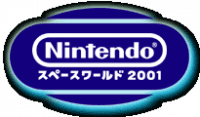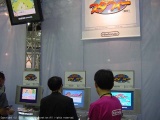Nintendo World
Nintendo World, formally known as Nintendo Space World (Japanese: 任天堂スペースワールド) is a video game trade show historically hosted near Tokyo and Kyoto in Japan. The first event was held in 1989, under a different name. One of the first notable events was the 1995 Shoshinkai (初心会) show, in which the Nintendo 64, previously known as the "Ultra 64" was officially revealed to the public with demos of The Legend of Zelda: Ocarina of Time (Zelda 64) and Super Mario 64. The last "Nintendo Space World" event occurred in 2001, revealing the Dolphin (Nintendo GameCube) and showcasing the Game Boy Advance. However in 2006, the event was continued under the name "Nintendo World". The latest "Nintendo World" event run from January 8th until January 10th 2011.
Official Guidebooks for Nintendo Space World were released annually and were apparently given out to everyone who attended the events. [1]
Nintendo Space World 2000

See also: Densetsu no Starfy (GBC)
The Nintendo Space World 2000 event was hosted at the Makuhari Messe (Japanese:幕張メッセ) exhibition centre, near Tokyo, Japan on August 25, 2000.[2] At the Nintendo Space World 2000 event, Densetsu no Starfy was showcased as a tentative title for the Game Boy Color. According to GameSpot, there were playable trial demos of Densetsu no Starfy, but there was a five minute time-limit until the game was reset in order to limit the player's progression. The game was scheduled for a release date of December 2000. The game still had a few pre-production items in place, including a debug menu.[3] There were a number of visible changes from the final game. The names of characters were changed, for example Moe was referred to as キョロロン (Kyororon) rather than キョロスケ (Kyorosuke), as he is referred to in the final game. The game used a different logo, which was carried on to the Nintendo Space World 2001 trial demo. The sprites of characters and enemies are considerably less detailed in the demo than the final game, due to the limited graphical capabilities of the Game Boy Color, and the official character artwork has changed throughout the development of Densetsu no Starfy.
Additionally, a trailer was shown at this event advertising the upcoming Densetsu no Starfy which can be viewed from the left-most Youtube video below.
Footage from what is presumably this version of the game (right-most Youtube video below) is still available in the form of a QuickTime movie on Nintendo of Japan's website on a page about Densetsu no Starfy when it was still a tentative Game Boy Color title, even though it has been years since the Nintendo Space World 2000 event has finished. Differences from the trial demo are still visible on the website.
Nintendo Space World 2001


The Nintendo Space World 2001 event was hosted at the same location as the Nintendo Space World 2000 event, at the Makuhari Messe (Japanese:幕張メッセ) exhibition centre, near Tokyo, Japan. The event ran from August 24, 2001. [4] At the time of the event, Densetsu no Starfy had already made the transition from a Game Boy Color title into a Game Boy Advance title, and was said to be 60% complete. The game was rescheduled for a release date of January 2002 in Japan, although the final product was not released until September 6, 2002 which was eight months later. [5] Before the release of the Game Boy Advance, Nintendo had encouraged developers to work on games for the upcoming console, as opposed to the Game Boy Color. This was also the cause of the development of two other Game Boy Color games, Tomato Adventure (then known as Gimmick Land) and the canceled Game Boy Music (which eventually became Daigasso! Band Brothers for the Nintendo DS) to move on to Game Boy Advance.
This demo of Densetsu no Starfy was also playable at Nintendo Space World 2001 via Game Boy Advance demo stations, along with games such as Fire Emblem: Fuuin no Tsurugi and the canceled Game Boy Advance game Luna Blaze. Compared with the Game Boy Color trial demo from Nintendo Space World 2000, the dialogue texts were made larger and easier to read, but the game still kept its tentative logo.[6]
-
Playable Densetsu no Starfy demo stations at the Nintendo Spaceworld 2001 event
External links
- All games shown at Nintendo Space World 2000 (in Japanese) (Published by Nintendo)
- All games shown at Nintendo Space World 2001 (Published by Nintendo)
- Densetsu no Starfy (tentative title) - Nintendo of Japan, 2000 (in Japanese)
- Densetsu no Starfy (tentative GBA title) - Nintendo of Japan, 2001 (in Japanese)
References
- ↑ STARMEN.NET - Mother 3 @ Nintendo Spaceworld '99
- ↑ Nintendo Spaceworld 2000 (in Japanese)
- ↑ Space World 2000: Hands On The Legend of Stafi - GameSpot.com (archived, old link)
- ↑ Nintendo Spaceworld 2001 (in Japanese)
- ↑ HeySpace World 2001: Hands-on The Legend of Stafi- GameSpot.com, (archived, old link )
- ↑ Game.Watch Nintendo Space World 2001 report
| List of prerelease information | Densetsu no Starfy • Densetsu no Starfy 2 • Densetsu no Starfy 3 • Densetsu no Starfy 4 • The Legendary Starfy |
|---|---|
| Lists of unused content | Densetsu no Starfy • Densetsu no Starfy 2 (test stage) • Densetsu no Starfy 3 (test stage) • Densetsu no Starfy 4 (test stage, unused models) • The Legendary Starfy (Helpful Stuff, test stage) • Test Stages (general information) |
| Unreleased games | Unused balloon/bubble pushing games / Densetsu no Starfy (Game Boy/Color) |
| Events and TV shows | Nintendo Space World (2000, 2001) • World Hobby Fair (2002, 2006) • Oha Suta • E3 (2009) |
| Media with relevant information | Game Boy Encyclopedia • Gekkan Nintendo • Nintendo Dream • Nintendo Power • Nintendo Spaceworld Official Guidebooks • Websites |
